An official website of the United States government
 United States Department of Labor
United States Department of Labor
Help carpenters by performing duties requiring less skill. Duties include using, supplying, or holding materials or tools, and cleaning work area and equipment. Construction laborers who do not primarily assist carpenters are classified under "Construction Laborers" (47-2061). Apprentice workers are classified with the appropriate skilled construction trade occupation (47-2011 through 47-2231).
Employment estimate and mean wage estimates for Helpers--Carpenters:
| Employment (1) | Employment RSE (3) |
Mean hourly wage |
Mean annual wage (2) |
Wage RSE (3) |
|---|---|---|---|---|
| 30,900 | 3.8 % | $ 17.00 | $ 35,360 | 0.9 % |
Percentile wage estimates for Helpers--Carpenters:
| Percentile | 10% | 25% | 50% (Median) |
75% | 90% |
|---|---|---|---|---|---|
| Hourly Wage | $ 11.47 | $ 13.60 | $ 16.48 | $ 19.47 | $ 24.02 |
| Annual Wage (2) | $ 23,850 | $ 28,290 | $ 34,280 | $ 40,490 | $ 49,950 |
Industries with the highest published employment and wages for Helpers--Carpenters are provided. For a list of all industries with employment in Helpers--Carpenters, see the Create Customized Tables function.
Industries with the highest levels of employment in Helpers--Carpenters:
| Industry | Employment (1) | Percent of industry employment | Hourly mean wage | Annual mean wage (2) |
|---|---|---|---|---|
| Residential Building Construction | 10,800 | 1.35 | $ 16.62 | $ 34,570 |
| Building Finishing Contractors | 5,300 | 0.66 | $ 16.50 | $ 34,310 |
| Nonresidential Building Construction | 4,420 | 0.55 | $ 18.82 | $ 39,150 |
| Foundation, Structure, and Building Exterior Contractors | 4,390 | 0.47 | $ 16.93 | $ 35,200 |
| Utility System Construction | 650 | 0.12 | $ 19.68 | $ 40,940 |
Industries with the highest concentration of employment in Helpers--Carpenters:
| Industry | Employment (1) | Percent of industry employment | Hourly mean wage | Annual mean wage (2) |
|---|---|---|---|---|
| Residential Building Construction | 10,800 | 1.35 | $ 16.62 | $ 34,570 |
| Building Finishing Contractors | 5,300 | 0.66 | $ 16.50 | $ 34,310 |
| Nonresidential Building Construction | 4,420 | 0.55 | $ 18.82 | $ 39,150 |
| Foundation, Structure, and Building Exterior Contractors | 4,390 | 0.47 | $ 16.93 | $ 35,200 |
| Furniture and Related Product Manufacturing (3371 and 3372 only) | 450 | 0.14 | $ 14.36 | $ 29,870 |
Top paying industries for Helpers--Carpenters:
| Industry | Employment (1) | Percent of industry employment | Hourly mean wage | Annual mean wage (2) |
|---|---|---|---|---|
| Colleges, Universities, and Professional Schools | 60 | (7) | $ 21.50 | $ 44,720 |
| Utility System Construction | 650 | 0.12 | $ 19.68 | $ 40,940 |
| Nonresidential Building Construction | 4,420 | 0.55 | $ 18.82 | $ 39,150 |
| Highway, Street, and Bridge Construction | 240 | 0.07 | $ 18.81 | $ 39,120 |
| Services to Buildings and Dwellings | 40 | (7) | $ 18.79 | $ 39,080 |
States and areas with the highest published employment, location quotients, and wages for Helpers--Carpenters are provided. For a list of all areas with employment in Helpers--Carpenters, see the Create Customized Tables function.
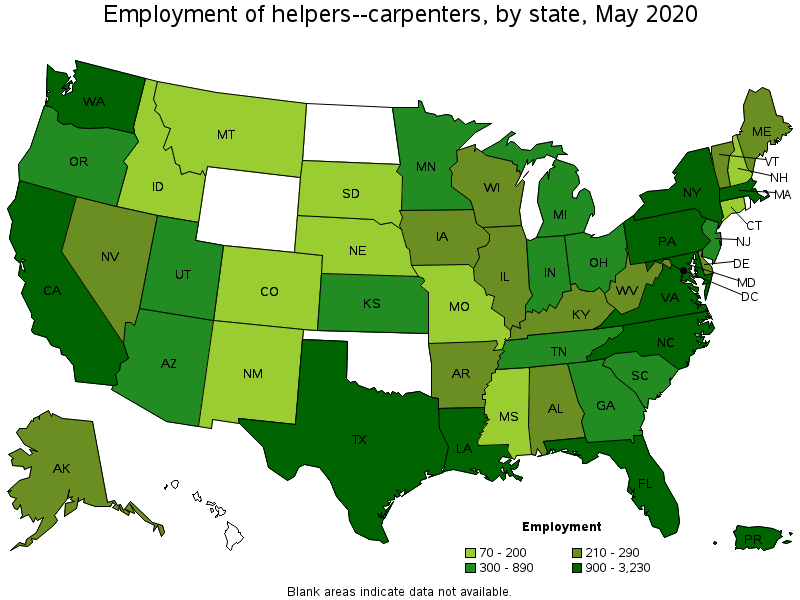
States with the highest employment level in Helpers--Carpenters:
| State | Employment (1) | Employment per thousand jobs | Location quotient (9) | Hourly mean wage | Annual mean wage (2) |
|---|---|---|---|---|---|
| California | 3,230 | 0.20 | 0.89 | $ 19.69 | $ 40,950 |
| Florida | 2,630 | 0.31 | 1.40 | $ 15.62 | $ 32,480 |
| Texas | 2,520 | 0.21 | 0.94 | $ 17.75 | $ 36,920 |
| Virginia | 1,980 | 0.53 | 2.40 | $ 14.41 | $ 29,980 |
| Washington | 1,660 | 0.52 | 2.34 | $ 18.33 | $ 38,120 |
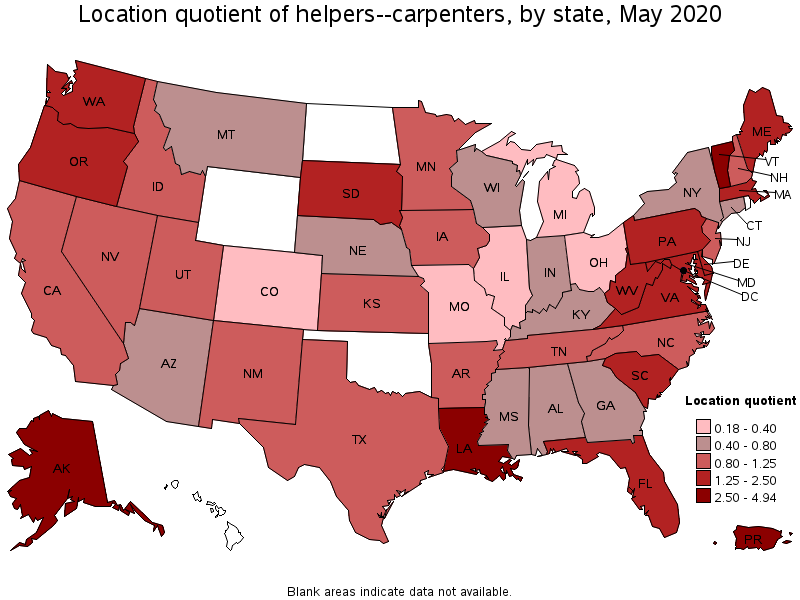
States with the highest concentration of jobs and location quotients in Helpers--Carpenters:
| State | Employment (1) | Employment per thousand jobs | Location quotient (9) | Hourly mean wage | Annual mean wage (2) |
|---|---|---|---|---|---|
| Alaska | 240 | 0.80 | 3.58 | $ 18.31 | $ 38,090 |
| Vermont | 210 | 0.73 | 3.29 | $ 16.94 | $ 35,230 |
| Louisiana | 1,010 | 0.56 | 2.52 | $ 16.67 | $ 34,670 |
| Virginia | 1,980 | 0.53 | 2.40 | $ 14.41 | $ 29,980 |
| Washington | 1,660 | 0.52 | 2.34 | $ 18.33 | $ 38,120 |

Top paying states for Helpers--Carpenters:
| State | Employment (1) | Employment per thousand jobs | Location quotient (9) | Hourly mean wage | Annual mean wage (2) |
|---|---|---|---|---|---|
| Oregon | 700 | 0.39 | 1.75 | $ 20.41 | $ 42,450 |
| District of Columbia | 120 | 0.18 | 0.79 | $ 19.77 | $ 41,120 |
| California | 3,230 | 0.20 | 0.89 | $ 19.69 | $ 40,950 |
| New York | 1,110 | 0.13 | 0.57 | $ 18.78 | $ 39,060 |
| Illinois | 220 | 0.04 | 0.18 | $ 18.63 | $ 38,760 |
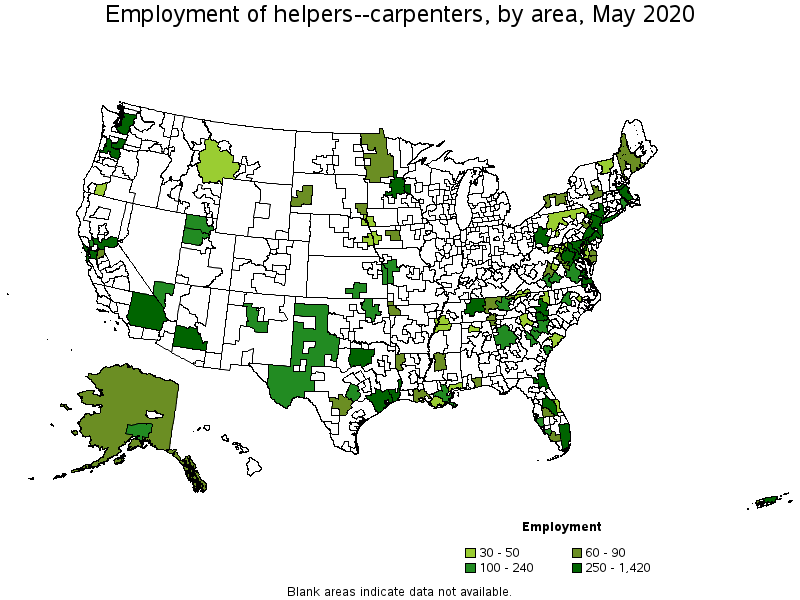
Metropolitan areas with the highest employment level in Helpers--Carpenters:
| Metropolitan area | Employment (1) | Employment per thousand jobs | Location quotient (9) | Hourly mean wage | Annual mean wage (2) |
|---|---|---|---|---|---|
| New York-Newark-Jersey City, NY-NJ-PA | 1,420 | 0.16 | 0.72 | $ 19.09 | $ 39,710 |
| Seattle-Tacoma-Bellevue, WA | 1,300 | 0.67 | 3.00 | $ 19.29 | $ 40,110 |
| Washington-Arlington-Alexandria, DC-VA-MD-WV | 1,140 | 0.38 | 1.70 | $ 17.00 | $ 35,360 |
| Houston-The Woodlands-Sugar Land, TX | 1,030 | 0.35 | 1.56 | $ 18.26 | $ 37,980 |
| Philadelphia-Camden-Wilmington, PA-NJ-DE-MD | 840 | 0.31 | 1.40 | $ 17.69 | $ 36,790 |
| Miami-Fort Lauderdale-West Palm Beach, FL | 770 | 0.31 | 1.39 | $ 15.82 | $ 32,910 |
| Boston-Cambridge-Nashua, MA-NH | 660 | 0.25 | 1.14 | $ 18.81 | $ 39,120 |
| Baltimore-Columbia-Towson, MD | 640 | 0.50 | 2.23 | $ 15.31 | $ 31,850 |
| San Francisco-Oakland-Hayward, CA | 590 | 0.25 | 1.13 | $ 21.58 | $ 44,900 |
| Riverside-San Bernardino-Ontario, CA | 570 | 0.39 | 1.74 | $ 18.75 | $ 39,000 |
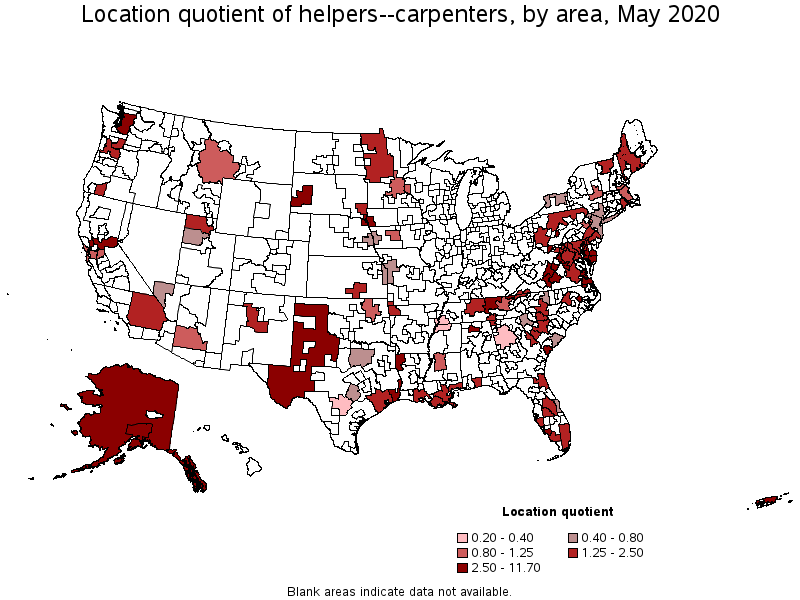
Metropolitan areas with the highest concentration of jobs and location quotients in Helpers--Carpenters:
| Metropolitan area | Employment (1) | Employment per thousand jobs | Location quotient (9) | Hourly mean wage | Annual mean wage (2) |
|---|---|---|---|---|---|
| Hilton Head Island-Bluffton-Beaufort, SC | 190 | 2.60 | 11.70 | $ 15.32 | $ 31,870 |
| Beaumont-Port Arthur, TX | 250 | 1.64 | 7.38 | $ 19.09 | $ 39,710 |
| Lynchburg, VA | 140 | 1.43 | 6.43 | $ 12.91 | $ 26,850 |
| Napa, CA | 100 | 1.42 | 6.41 | $ 20.42 | $ 42,460 |
| Rapid City, SD | 60 | 1.00 | 4.50 | $ 14.63 | $ 30,430 |
| Roanoke, VA | 140 | 0.98 | 4.40 | $ 14.85 | $ 30,880 |
| Staunton-Waynesboro, VA | 40 | 0.95 | 4.27 | $ 14.59 | $ 30,340 |
| Anchorage, AK | 140 | 0.87 | 3.92 | $ 17.43 | $ 36,260 |
| Cape Coral-Fort Myers, FL | 230 | 0.86 | 3.88 | $ 16.24 | $ 33,780 |
| Altoona, PA | 50 | 0.86 | 3.87 | (8) | (8) |
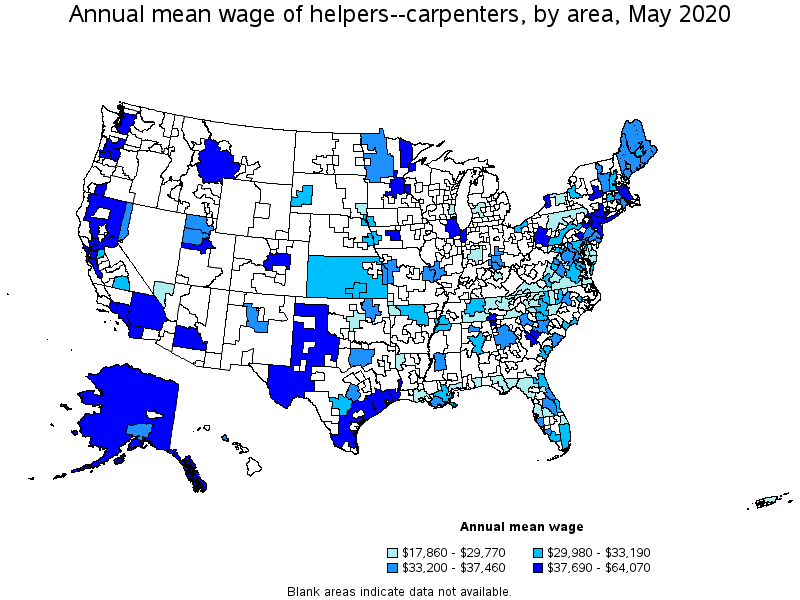
Top paying metropolitan areas for Helpers--Carpenters:
| Metropolitan area | Employment (1) | Employment per thousand jobs | Location quotient (9) | Hourly mean wage | Annual mean wage (2) |
|---|---|---|---|---|---|
| Salem, OR | (8) | (8) | (8) | $ 30.80 | $ 64,070 |
| New Bedford, MA | 30 | 0.54 | 2.45 | $ 21.98 | $ 45,720 |
| San Francisco-Oakland-Hayward, CA | 590 | 0.25 | 1.13 | $ 21.58 | $ 44,900 |
| Medford, OR | 30 | 0.36 | 1.64 | $ 21.23 | $ 44,160 |
| Buffalo-Cheektowaga-Niagara Falls, NY | 90 | 0.17 | 0.78 | $ 20.63 | $ 42,920 |
| Vallejo-Fairfield, CA | (8) | (8) | (8) | $ 20.54 | $ 42,730 |
| Los Angeles-Long Beach-Anaheim, CA | (8) | (8) | (8) | $ 20.44 | $ 42,510 |
| Napa, CA | 100 | 1.42 | 6.41 | $ 20.42 | $ 42,460 |
| Oxnard-Thousand Oaks-Ventura, CA | (8) | (8) | (8) | $ 20.40 | $ 42,430 |
| Des Moines-West Des Moines, IA | 90 | 0.26 | 1.19 | $ 20.26 | $ 42,150 |
Nonmetropolitan areas with the highest employment in Helpers--Carpenters:
| Nonmetropolitan area | Employment (1) | Employment per thousand jobs | Location quotient (9) | Hourly mean wage | Annual mean wage (2) |
|---|---|---|---|---|---|
| West Texas Region of Texas nonmetropolitan area | 190 | 0.97 | 4.38 | $ 19.12 | $ 39,770 |
| Northwest Virginia nonmetropolitan area | 90 | 1.52 | 6.82 | $ 13.67 | $ 28,420 |
| North Central Tennessee nonmetropolitan area | 90 | 0.83 | 3.74 | $ 12.81 | $ 26,630 |
| Alaska nonmetropolitan area | 80 | 0.76 | 3.42 | $ 20.37 | $ 42,370 |
| Northwest Minnesota nonmetropolitan area | 70 | 0.37 | 1.67 | $ 17.06 | $ 35,480 |
Nonmetropolitan areas with the highest concentration of jobs and location quotients in Helpers--Carpenters:
| Nonmetropolitan area | Employment (1) | Employment per thousand jobs | Location quotient (9) | Hourly mean wage | Annual mean wage (2) |
|---|---|---|---|---|---|
| Northwest Virginia nonmetropolitan area | 90 | 1.52 | 6.82 | $ 13.67 | $ 28,420 |
| West Texas Region of Texas nonmetropolitan area | 190 | 0.97 | 4.38 | $ 19.12 | $ 39,770 |
| North Central Tennessee nonmetropolitan area | 90 | 0.83 | 3.74 | $ 12.81 | $ 26,630 |
| Alaska nonmetropolitan area | 80 | 0.76 | 3.42 | $ 20.37 | $ 42,370 |
| Maryland nonmetropolitan area | 30 | 0.56 | 2.51 | $ 14.27 | $ 29,670 |
Top paying nonmetropolitan areas for Helpers--Carpenters:
| Nonmetropolitan area | Employment (1) | Employment per thousand jobs | Location quotient (9) | Hourly mean wage | Annual mean wage (2) |
|---|---|---|---|---|---|
| North Valley-Northern Mountains Region of California nonmetropolitan area | (8) | (8) | (8) | $ 23.06 | $ 47,960 |
| Coastal Plains Region of Texas nonmetropolitan area | (8) | (8) | (8) | $ 22.40 | $ 46,600 |
| Alaska nonmetropolitan area | 80 | 0.76 | 3.42 | $ 20.37 | $ 42,370 |
| West Texas Region of Texas nonmetropolitan area | 190 | 0.97 | 4.38 | $ 19.12 | $ 39,770 |
| Southwest Montana nonmetropolitan area | 30 | 0.23 | 1.05 | $ 18.48 | $ 38,440 |
These estimates are calculated with data collected from employers in all industry sectors, all metropolitan and nonmetropolitan areas, and all states and the District of Columbia. The top employment and wage figures are provided above. The complete list is available in the downloadable XLS files.
The percentile wage estimate is the value of a wage below which a certain percent of workers fall. The median wage is the 50th percentile wage estimate—50 percent of workers earn less than the median and 50 percent of workers earn more than the median. More about percentile wages.
(1) Estimates for detailed occupations do not sum to the totals because the totals include occupations not shown separately. Estimates do not include self-employed workers.
(2) Annual wages have been calculated by multiplying the hourly mean wage by a "year-round, full-time" hours figure of 2,080 hours; for those occupations where there is not an hourly wage published, the annual wage has been directly calculated from the reported survey data.
(3) The relative standard error (RSE) is a measure of the reliability of a survey statistic. The smaller the relative standard error, the more precise the estimate.
(7) The value is less than .005 percent of industry employment.
(8) Estimate not released.
(9) The location quotient is the ratio of the area concentration of occupational employment to the national average concentration. A location quotient greater than one indicates the occupation has a higher share of employment than average, and a location quotient less than one indicates the occupation is less prevalent in the area than average.
Other OEWS estimates and related information:
May 2020 National Occupational Employment and Wage Estimates
May 2020 State Occupational Employment and Wage Estimates
May 2020 Metropolitan and Nonmetropolitan Area Occupational Employment and Wage Estimates
May 2020 National Industry-Specific Occupational Employment and Wage Estimates
Last Modified Date: March 31, 2021